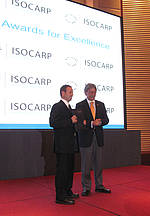
ISOCARP Awards Ceremony (26-10-2011)
In 2011 the project Rahat: Planning the Largest Bedouin City in the World – Coexistence in the Middle East was awarded the ISOCARP Award for Excellence. Project leader Amos Brandeis received the award at the award ceremony at the 2011 ISOCARP Congress in Wuhan.
The ISOCARP Awards for Excellence have the potentional to bring many benefits to the winner. For example, the Award helped spread the word about the Rahat project and even drew the attention of Shimon Peres.
Award Winner Amos Brandeis summarises his experiences:
„The ISOCARP Award for Excellence had an amazing impact on my project “Rahat – The Bedouin City”. It was a major factor for the planning of new challenging projects, and even led me to a personal meeting with the President of Israel, Mr. Shimon Peres, to discuss the project.“
Rahat – Planning the Largest Bedouin City in the World – Coexistence in the Middle East
The Excitement and Potential of Winning the ISOCARP Award for Excellence
Architect Amos Brandeis, Israel.
www.RestorationPlanning.com
E-mail: amos-br@inter.net.il
Standing on the stage at the Gala Awards Dinner in China, during the ISOCARP annual conference (October 2011), and receiving the prestigious 2011 ISOCARP Awards for Excellence, was exciting. But this was only the beginning of the next chapter of the marvelous journey of this project: “Rahat – Planning the Largest Bedouin City in the World – Coexistence in the Middle East“. Like a good thriller, every chapter, has new dimensions, new stars, and new records of excitement. No doubt that winning the Award opened new horizons for the project, and for me as its planner.
-
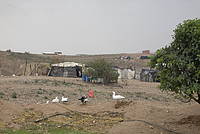
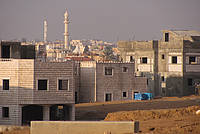
Before & After 2004 – 2011
- The first chapter of this project is about how it all started. Ten years ago, I received a strange phone call, and was asked on behalf of The Negev’s Bedouin Settlements Authority, the National Land Authority, and the Municipality of Rahat, if I want to plan the new part of the Bedouin city. I had to give an immediate answer. I said: “Yes. Why not.”
A few days later I was invited to the city council. It was in the evening. Dark. Almost no street lighting. I didn’t know anything about the Bedouins. I was introduced, and the Mayor asked me: “What did you plan for us? Can we see the plans?”. This was the mentality and reality in those days. They expected somebody to plan for them. I answered: “I haven’t started to plan, I was never here before. I propose to you two alternatives: that I will study alone the characters of the place and the community, and I will sit in my office and plan what I think is suitable for you, or that we work together and make this plan in full collaboration. Either way I will be paid the same, so as far as I am concerned the first alternative is more economic for me, your decision.” Immediately after I said this, the head of the council’s opposition stood up and said: “This is the first time we were ever asked how we want our children to live. We cannot let this opportunity go. I ask you all to collaborate fully with the planner.”
Since then till today, over the past decade, we have successfully collaborated together.
The second chapter of this project was planning. Over 10 years, a methodic and integrative planning process with the collaboration of dozens stakeholders, was carried out, from the structural-urban level (scale 1:10,000) for 12,000 housing units, through outline schemes in the new and existing fabric for about 9,000 housing units, up to detailed construction plans (scale 1:10). Through constant public participation process the peoples trust was gained, the unique needs and desires of different tribes and age groups were studied and the plans addressed them. The community developed pride of the place, ownership and belonging.
The plans emphasized the creation of one unified city, in its core the general public facilities, and “Green fingers” connecting to the depth of the residential fabric. While previous plans were tribal based, the new plan creates a complex urban network of streets, addressing the need of various extended family size, desires of different age groups and allowing flexibility. 9 house models were outlined to address the different needs and economical capabilities.
-
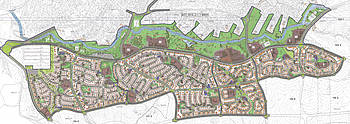
Compilation of plans for Southern Rahat
- The plan responds to the unique cultural and social values, e.g. joint public institutions outside the neighborhoods; maintaining woman modesty; facilitating women employment; creating “Shig”s (social clubs); housing units that can accommodate polygamy.
The third chapter of this project is about the implementation and construction. It started with a dramatic event. On the 10th of August 2004, PM Arik Sharon, came to set the corner stone for this project. He promised to visit the site every few weeks, to make sure everything goes right. Unfortunately, a few months later, he fell into a coma.
- A total amount of 100 million Euros were dedicated for the first stage of developing infrastructures, while more than half were already invested in the project. The first houses in the new neighborhoods started being built by the Bedouins in 2011. Site visits proved how thrilled the Bedouins were in building their new homes.
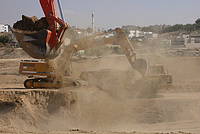
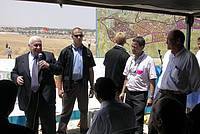
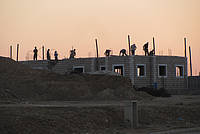
- This could have been the end of this decade long story. But another surprise happened, to begin the fourth chapter of this project. The turning point was winning the “2011 ISOCARP Awards for Excellence“. This was not only a simple award. This is an international recognition, on the highest level. A huge honor and challenge. How can you feel, when you stand on the stage between Amsterdam and Abu Dhabi, to receive an award?
The project, which was relatively unknown in Israel, received great PR following the prize, on general newspapers and in a professional magazine, which wrote its main article on the project (8 pages).
This could have been the end of this decade long story. But another surprise happened, to begin the fourth chapter of this project. The turning point was winning the “2011 ISOCARP Awards for Excellence“. This was not only a simple award. This is an international recognition, on the highest level. A huge honor and challenge. How can you feel, when you stand on the stage between Amsterdam and Abu Dhabi, to receive an award?
The project, which was relatively unknown in Israel, received great PR following the prize, on general newspapers and in a professional magazine, which wrote its main article on the project (8 pages).
-
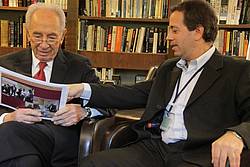
Amos Brandeis explains President Shimon Peres the project (9.1.12). Credit: Mr. Jossef Avi-Yair Engel (Jucha) – Advisor to the President
President Shimon Peres heard about the project and the award, and invited me to a personal meeting in January 2012. I explained him the project and the future challenges. He was also very interested to hear about the award and ISOCARP. He, an amazing and energetic man (age 88), asked many questions, and we had a discussion of about 1.5 hours. He was enthusiastic, and immediately raised ideas and ways to help develop further the Bedouin city. He wants to bring Rahat to new levels of success and equality, and the Negev residents to a higher degree of co-existence.
The interest of President Peres in the area of planning, and his personal support is a real asset, that will hopefully upgrade the story of this project to new levels in the next chapter, which I hope to be able to write in the near future.
This is a project that makes a difference. It demonstrates how powerful planning can act as a tool to promote co-existence of communities, working in mutual trust and collaboration with indigenous people, and developing hope and better life for them.
I believe that if it can be done in the Middle East, it can even be done in some other places.
I never forget to thank my client, and all other partners, consultants, friends and colleagues, and my family, who had all a vital role in this project. Planning is a team work. If you have a common vision, leadership, and collaboration, you can succeed even with projects like this, which started “against all chances”. But special thanks to ISOCARP. The award opened new horizons for this project. I can only recommend all planners to submit a nomination next year. The excitement and potential are immense.
I am proud to win the award as an Israeli, to demonstrate that in our country also other things happen. Not only what you see in the media. But, more than all, I am proud to be a planner. We have a wonderful profession.
Rahat: Planning the Largest Bedouin City in the World – Coexistence in the Middle East